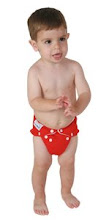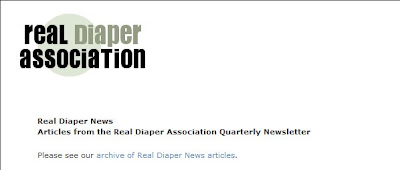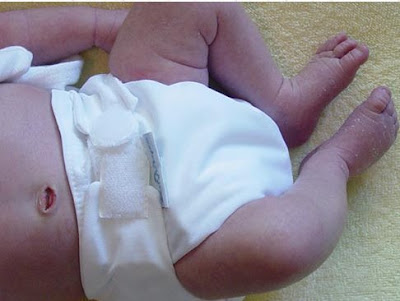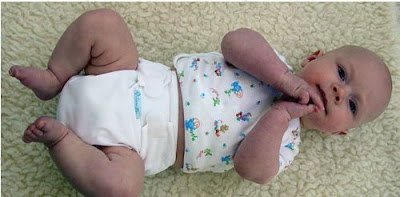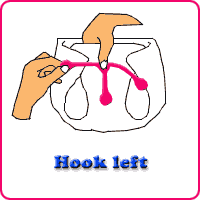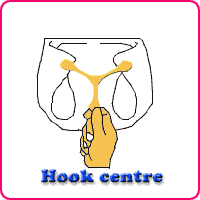CLOTH DIAPERING TIPS AND INFOS
- What is Cloth and Disposable Diaper?
- Why Use Cloth Diaper?
- Intro To Cloth Diapering
- Astronout Worn Diapers?
- First Year Cost of Having A Baby
- How Much Diapers Cost?
- 10 Tips Of Money Saving (from Fuzzi Bunz)
- What You Need to know before buy the Cloth Diaper?
- Cloth Diaper Accessories
- Do It Yourself - Cloth Diaper
- How To Sew Cloth Diaper?
- All In One Cloth Diaper ( see on baby )
- Tip For Cloth Wipes
- Cloth Diaper On News
- "Don't be afraid to use bleach" on cloth diaper
Cloth Diapering Show
Tuesday, July 1, 2008
Biggest Issues of Cloth diapers
Solution; Buy wool for night time to help with leaks. Even if you don't use it any other time. Or
type="text/javascript">
switched to All In One (AIO) cloth diaper for night time. Like, Thirsties pocket AIOs . It double stuffed with either Babyology longies or Sbish pants.
If you don't want to invest much money you can make recycled wool longies (or shorties and soakers).
How Often I change ? Frustrated?
Why cloth diapers leak during the day?
This was a problem I couldn't figure out in the beginning with cloth diapers.
type="text/javascript">
Unfortunately, in this day of convenience we have been led into thinking that a diaper should last all day or at least until it sagging down to the baby's knees.
If you used disposables atany point and then made the switch to cloth you may have a hard timeadjusting to the absorbency difference. The chemical compound in disposable diapers responsible for absorption can hold up to 300 times its weight in tap water. That is far more than cotton, hemp, or microfiber used in cloth diapers.
It is suggested that a cloth diaper be change every two hours. Oddly enough, I read this to be true of disposables. I will admit though when I used disposables I went a lot longer than 2 hours between changes.If you expect a cloth diaper to last 3, 4, or more hours then you will be let down. Then you will get so frustrated that you may give up on cloth diapers.
Anytime I have had "wicking" it is because I have left the diaperon for toolong. When I make an effort to change my little one consistently(before the point of a wet lap or when I am forced to because she pooped) I am much happier with my cloth diapers.
RELATED ITEMS:
1. Cloth Diaper Accessories
2. How to wash cloth diaper
3. Removing urine smell
4. How to use Snappi Fasterner
5. Don't be afraid to use bleach
6. Biggest Issues of Cloth Diaper
Monday, June 30, 2008
How To Make All In One (AIO) Cloth Diaper?
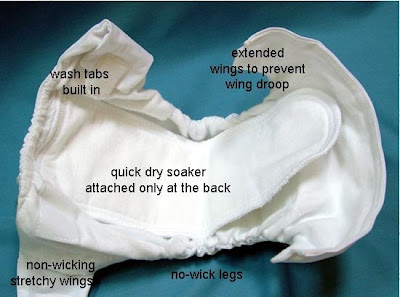
Step1
Choose the fabrics. Having the inner lining made of fleece and the outer lining made of flannel works well, but the color and patterns are up to you. You don't have to buy new material, but cut up old flannel blankets, shirts or whatever fabric that suits you.
Step2
Cut open a brown paper bag to use as pattern paper, and draw an hourglass shape. You can use another cloth diaper as a template.
Step3
Snip out your pattern piece and place it on the fabric for your cloth diaper. Have the right side of the fleece facing the right side of the flannel. Trace around the pattern piece with a pencil, then use a ruler to add ½ inch seam allowance all the way around. Cut out the fabric around the outer line.
Step4
Create a soaker out of a rectangular piece of burly terry cloth. This should run the length of the diaper. Pin this to the wrong side of the fleece and sew it into place. You can have two layers of soakers should you have a heavy wetter.
Step5
Measure the thighs of your baby and cut two lengths of ¼ inch elastic the length of the baby's thigh. Pin this to the wrong side of the flannel and sew it into place, being careful to make certain the elastic is stretch as you do so.
Use a zig-zag stitch on your sewing machine or an elastic stitch if you have those options. Measure the baby's back, and cut a piece of elastic to length. Stretch this along the whole back of the wrong side of the flannel, pin and sew it in place.
Step6
Pin the two fabric pieces together, and sew around the stitch line on a sewing machine. Leave one end open. Turn the fabric right side out, and close the open end by hand or with a sewing machine.
type="text/javascript">
Step7
Close the diapers with either diaper pins or by sewing Velcro tabs on the diapers. Either option makes the cloth all-in-one diaper adjustable.
Do Search here on How to make All In One Cloth Diaper

Custom Search
Sunday, June 29, 2008
What the Cloth Diaper Accessories?

Diaper Accessories
When you swicth to the cloth diapering, you have many options in term of these diapers and accessories. While they are not required for each type of diaper you buy, they oftentimes enhance the performance of the cloth diaper, and sometimes just make you life as a parent a little bit easier.
Some options include waterproof diaper bags, inserts to add absorbency to the diapers and hemp Washies to replace disposable diaper wipes. These products, like the cloth diapers themselves, are machine washable and environmentally friendly.
Also available are liners that keep your baby dry and his skin soft, fasteners to keep the diapers in place and replace safety pins, and portable changing pads for when you and your baby are on the go.
Saturday, June 28, 2008
What is All in One cloth diaper? (for working mother especially)
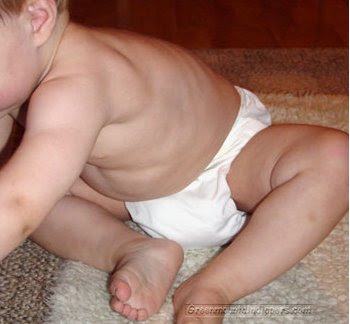
(26 month baby on All in One cloth diaper)
What is an all-in-one diaper (AIO)?
An all-in-one diaper is a diaper and cover built together so it's one piece. All-in-one ("aio") diapers do not require a cover, because the cover is sewn onto the diaper already, hence the name "all-in-one".
All-in-one diapers can be used full time for the easiest possible method of cloth diapering. While still a bit less expensive than disposable diapers, they are more expensive than separate diaper and cover systems. But the convenience of the all-in-one diapers can't be beat!
Even if you choose a separate diaper and cover system, it’s great to have at least a few all-in-ones on hand for times when you’d like the extra convenience of an all-in-one.
All-in-ones are the perfect diapering choice for those who are making the switch from disposables to cloth for the first time. They are so easy to use! But, because the waterproof layer connected to the diaper, it takes a beating at washtime and aios in larger sizes do not last as long as separate diaper and cover systems. But the convenience can't be beat.
We don't recommend aios for overnight or long-term diapering (long-term diapering means going a very long time between changes), unless you use a doubler or 2 and a cover over it.
(Exception: aios may be a good choice for overnight for a child who is transitioning to becoming night toilet trained, because of the ease of getting them on and off to use the toilet and the because of trimness of them, which is usually more acceptable and comfortable to day-trained children who are used to underwear, but need something still at night just in case.
AIOS are great for potty learning.)
Xtra Small 4 to 9 pounds (for brand new newborns or large preemies)
Small 10 to 19 pounds (compares to size 2 and 3 disposable)
Medium 19 to 30 pounds (compares to size 4 disposable)
Large 28 - 50 pounds (age 2 to age 5, quite a bit more rise than a medium, snap version has 2 rows of snaps)
Thursday, June 26, 2008
All-In-One (AIO) Diaper(YouTube)

No separate cover is needed. Unlike a pocket diaper, there is no need to stuff it, and nothing to strip. It is truly easy. Spouse and daycare friendly. It goes on and fits just like a disposable diaper. People who are used to disposable diapers and with unfamiliar cloth diapers will be comfortable using these.
100% cotton inside, non-allergenic. No polyester fleece inside. No microfiber
Monday, June 23, 2008
Pocket Diaper
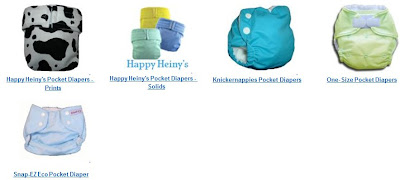
Diaper cover

Yet comfort is the goal with these diaper covers. They were designed to offer premium protection without discomfort due to harsh materials. All diaper covers prevent wetness from getting on your child's clothing.
Are cloth or disposable diapers best during travel?
Laura Sutherland, family travel writer
When traveling for short distances or limited periods of time, some parents simply stick with the kind of diapers they use at home. For long travel days or extended trips, however, there's no question that disposable diapers are the most convenient choice.
Disposable diapers eliminate the need to cart dirty diapers around. They also save you from spending time finding — and using — laundry facilities. Of course, if you have access to a washing machine at your destination, you can use whichever kind of diapers you prefer.
Take special care in laundering dirty diapers away from home, though. If they're not properly washed, your baby could get a diaper rash. If you're traveling in developing countries or remote areas, whether you're using cloth or disposable, you'll probably have to carry the soiled diapers with you until you can dispose of or clean them properly. Although cloth diapers might seem like the more ecologically correct choice, depositing the waste water used to clean them can be a problem. Disposables do have some advantages over cloth: They hold more liquid so you won't have to change your baby's diaper as often and they weigh less.
Autumn Beck said, "Don't be afraid to use bleach"
This is an extremely rare event (I have only heard of it once inmy years of cloth diapering) but for me the thought is enough.
Bleach is also helpful when your diapers have major buildup. I have soft water where we live. Because of this, detergent gets trapped in the diaper fibers causing the diaper to stink, decrease absorbency and create rashes on the baby.When using bleach start the wash and add about ¼ cup to the cycle 5minutes after agitation has started.
I do it this was simply because I don't want to take the chance of bleach sitting directly on the diapers.I suggest doing an extra rinse cycle with very hot water after you use bleach.
10 Interesting Tips of money saving from Fuzz Bunz
Here are 10 suggestions from your friends at Fuzzi Bunz about how you can save money when baby makes three.
1. Commit to using reusable products, such as reusable diapers, reusable bibs and reusable cups. You will save a lot of money in the long run and do your part to make this world a better place.
2. Breastfeed if you can. You will save lots of money on expensive formula and you'll be doing the best thing for your baby and the environment (talk about eating locally!).
3. Borrow, borrow, borrow. Borrow as much baby stuff as you can, including a crib, sheets, stroller, clothes and breast pumps (be sure to purchase new attachments, etc.).
4. Look for furniture and accessories that double as something else. For example, your changing table can double as your dresser, and a high chair can convert into a booster seat when your baby is ready to sit at the family table.
5. Take advantage of your local library. Borrow books, music and videos for free and participate in free storytimes - a great way for you and your baby to meet new people and make life-long friends.
6. Ask your doctor for samples and coupons. Your doctor may have a large stash of formula, rash ointments and medicines, so be sure to ask and you will likely receive something.
7. Warm up to garage sales. Garage sales and online websites. Just be sure the items are in good shape and beware of items that may have been recalled.
8. Register for everything. Make sure your registry includes everything from your crib sheets and onesies
9. Trade with friends. Trade everything from different forum brand samples and discarded toys with other moms.
10. Shop online. Many deals on your favorite brands are available online so shop wisely and compare prices.
Also, do a Google or Yahoo search for a coupon code to your favorite store. You may find that the once expensive, top-of-the-line car seat is 20% less online and is now within your budget.
Related Item:
1. First-Year Baby Costs Calculator
Friday, June 20, 2008
What you need to know before buy the cloth diaper
Here are some tips, ideas, and other facts that you need to know before start but the cloth diaper.
There are several differant kinds of cloth diapers. They are:
1. All in one
2.Diaper Doublers or Liners
3.Fitted Diapers
4.Pre-folded Diapers
5.Flat or Square Diaper
6.Hemp, Sherpa, or Wool Diapers
7.Polar Fleece
8.Pocket Diapers
9.Snap to fits
10.Soakers
Possible many more than listed above. Every person has a different need for cloth diapering, and with so many different kinds out there it is nice to have such a choice.
All in one is always parent's favourite,most likely because it is the easiest to use,it isn't expensive, it just isn't cheap,though it is cheaper than repeatedly buying disposables.
Pocket Diapers are nice also, and Snap to fits are nice because they can fit for such a long time, even the pocket look funny. At same time Snap fit still fit for 2 year old and 6 month old baby.
They're not terribly hard to make you own cloth diapers,but it is important to use the right kind of fabric on the inside to keep it from wetting through. There are always covers that can be added to the diapers. Also, the covers can made from almost any fabric, so the babies can look very cool in their cute homemade cloth diapers.
Did you know that disposable diapers can be an asthmatic reaction, and the products and chemicals are not good for the baby's skin? So why not change to cloth diaper,because it will let you use an olden days method,that obviously worked for hundreds of years,and it better for baby anyways.
Just remembering that you can later resell the diapers on EBAY for about 75% of the cost you put into them and get your money back,rather than disposable diapers.
They are even some different accessories to make cloth diapering even easier.
Wet bag, a bag that doesn't let the smell through can be used in the diaper bag to hold dirty diapers,liners can be rewashed or some even flushed with the baby's potty. And there are bags and holders for the home,like bigger wet bags,and there are still buckets,and even homemade wipes can be made for those who are really into it.
That some of the pros and cons of cloth diapering, it would be a good idea to check them out yourselves.
Thursday, June 19, 2008
Do it Yourself Cloth Diaper
The most frequently asked questions about sewing diapers generally revolve around what type of machine(s) to use, what pattern to use, which fabrics and notions are best, how diapers are constructed, and where to purchase diaper making supplies.
In order to sew diapers that will hold up to all the wear and tear they will receive once they are put into use you need a sewing machine that can efficiently and neatly sew through several layers of fabric and perform both a zigzag and straight stitch. A fancy, expensive machine is not necessary!
Many diaper sewers also find a serger (or overlock machine) indispensable. Diapers can be sewn with just a traditional sewing machine, however, a serger provides several key benefits including: the ability to finish the edges of a diaper by serging which is much faster than the traditional turned and topstitched method necessary with a traditional sewing machine, the ability to serge internal soaker pads which ensures that they will not fray, and the ability to serge doublers, pocket inserts, and fold out soakers (all of which are done more efficiently with a serger).
Regardless of the type of machines you have, you need to make sure they are in good working order. If you machine is skipping stitches, creating loose or uneven stitches, or in any other way not performing correctly you should have it services before you begin sewing diapers.
Always make sure that you are sewing with a sharp needle, and that you machine is well oiled (if it requires oiling) and free from excess lint and dust.
There are many ready for purchase diaper sewing pattern available. Most are available only online (search the web for ‘diaper sewing pattern’), however a few traditional pattern manufactures have diaper patterns that are available at sewing stores. There are also numerous free diaper patterns available online (search the web for ‘free diaper pattern’).
Which diaper pattern is best is purely a matter of opinion! There are as many preferences as there are cloth diapering parents. If you have used cloth diapers in the past choose a pattern that closely resembles the style of diapers you prefer.
If you are completely new to cloth diapering it is generally recommended that you join an online cloth diapering discussion list, do extensive research online, and ‘window’ shop online stores in an effort to discern which style of cloth diapering you prefer.
Doing your research ahead of time will ensure that you don’t waste time and money on diapers you won’t like! If you have cloth diapering and sewing experience it is a fairly simple process to create your own pattern. A disposable or favorite cloth diaper can be traced as an initial pattern. Use inexpensive fabric to sew up a ‘test’ diaper, and then alter your original pattern as needed until you have created a diaper you are happy with. Cut notches on your diaper pattern where the elastic will stop and start, and then cut corresponding notches on your fabric when cutting it out.
That way you’ll always know exactly where to sew your elastic on! Many diaper sewing websites offer basic diaper measurements for various sized diapers that are very helpful when creating your own pattern from scratch. Home made patterns can be traced onto felt, cardboard, poster board, etc to preserve them.
There are many, many fabrics that are excellent for diapers. For beginning sewers 100% cotton flannel is probably the best choice. Flannel is easy to sew with, soft and absorbent. It can also be found inexpensively at fabric stores and large chain discount stores.
All fabrics should be washed before they are cut and sewn! Washing shrinks the fibers of the fabric, and removes any remaining dyes and chemicals from manufacturing. When you are ready to move beyond flannel, keep in mind that first and foremost diapers need to be absorbent!
Natural fibers such as hemp, cotton, wool and silk are absorbent. Synthetic fibers such as polyester, nylon, spandex, etc are not absorbent. When you are selecting fabrics for your diapers it is generally best to select those that contain 100% natural fibers. Synthetic fiber fabrics do have their place in diaper sewing, and whether or not to use them is personal preference. Fabrics like poly fleece, micro fleece and suede cloth are often used as the inner layer of diapers because they have a ‘stay dry’ effect.
Common natural fiber fabrics used in cloth diapering include: flannel, terry, stretch/French terry, sweatshirt fleece, sherpa (which is generally a high percentage cotton blend that includes some polyester), hemp fleece, hemp jersey, hemp terry, velour, and birdseye.
Diaper sewing fabrics can be found at sewing stores, and online (search the web for ‘diaper sewing fabric’). Notions are equally important as fabric when making diapers. Basic diaper sewing notions include: thread, elastic, and diaper closures (hook & loop tape, snaps, buttons or pins).
Using a good quality thread is important to the life span of the diaper. When it comes to thread, you generally get what you pay for. Fiber contents may be the same, but higher quality threads are spun better and perform better.
There are many types and widths of elastic available. Simple braided elastic works very well in diaper. Most sewers prefer ¼ inch wide elastic, though slightly wider (3/8 inch) elastic is used as well. Diaper closures are yet another matter of personal preference.
Hook and look tape (such as Velcro, aplix, touch tape, etc) is readily available and doesn’t require any special tools to apply. Hook & loop tape should be sewn onto the diaper with a zigzag stitch around its outer edges.
Plastic snaps are preferred by many diaper sewers because they are easy to apply, look nice, don’t rub on baby legs like hook & loop can, and after the initial investment of a snap press the snaps are very inexpensive. A special industrial hand press is required for the application of plastic snaps. The presses are expensive, and are only available online (search the web for ‘diaper snap press’). There are other less expensive snap setters and pliers; however, the quality and ease of use are questionable.
Buttons and buttonholes are cute and functional closures for diapers, however it is time consuming to sew them on and the buttons present a potential choking hazard if they fall off.
Diapers can also be left without sewn on closures, and then pinned closed with traditional safety pins. Diaper construction is fairly simple.
A diaper consists of at least 2 body layers (the inside and outside of the diaper) and a soaker (the multilayered absorbent core of the diaper). On a sewing machine the soaker is sewn to one of the body layers of the diaper, and then the two body layers are placed right sides together and a seam is sewn around the edges of the diaper (a ¼ to ½ inch seam allowance is acceptable) with an opening being left to turn the diaper right sides out.
For a fitted diaper, elastic is sewn in the seam allowance at the legs and back of the diaper. The ends of the elastic should be tacked down with a zigzag stitch at their stop and start points. Then the diaper is turned right sides out, the opening is sewn closed and the diaper is topstitched paying close attention around the elastic to ensure that it is not sewn over!
The topstitching will create a casing for the elastic so that it does not shift around the inside of the diaper. After the diaper is sewn, closures are applied. If the diaper is being serged the soaker is again sewn to one of the body layers. The elastic is then sewn to the body of the diaper as well. The elastic should be sewn in place ½- 1 inch from the edge of the diaper (this will place it well inside of the edge that will be serged). The elastic can be tacked down at each end with a zigzag stitch, or it can be stretched tight and sewn down its entire length with a 3 step zigzag stitch).
The body layers of the diaper are then placed together right sides out, and the edges are serged. Topstitching can be done in the areas with elastic if a casing is needed. It is a good idea to pin the layers of your diaper so they don’t shift around while sewing. Be sure to remove all the pins!
Diaper sewing supplies can be purchases at fabric stores, chain discount stores and online. Creative sewers can find materials at yard sales and thrift stores. Many things can be used for sewing diapers, just keep in mind that diapers have to be comfortable, absorbent and sturdy and you can’t go wrong!
Wednesday, June 18, 2008
Environment Laundry Detergent for cloth diaper

(sample product for laundry care,refer Diapersetc.com and pinstripesandpolkadots.com
While taking great care of the diapers and they save you money as they stretch out the longevity of the fabric.
Wool requires specific care,to keep your wool diapers in great condition and keeps the wool extra absorbent and usable for years to come.
Regular Care of Cloth Diaper
Additional instructions for common accessories are described below.
For dirty diapers, first dump as much poop as you can into the toilet and flush. Some people like to squirt a little enzyme-based stain remover on the dirty diapers at this point. Then place the dirty diaper in your diaper pail. Don't worry if you can't get all the poop out of the diaper--infants have runny poop and most toddlers have semi-solid poop for a couple of months, or years.
It's okay if some poop runs through your washing machine, as the wastewater will go to your local water treatment plant, who will be equipped to deal with it just as they would the wastewater from your toilet. You don't need to wash the cover unless it has poop on it, or if it smells bad. Just hang it to dry, preferably in a sunny spot.
For wet diapers, just place the wet diaper in your diaper pail. You only need to wash wet diaper covers if they smell strongly of urine (let your nose be the judge).
When your diaper pail is full, empty it into your washing machine and soak for 8 hours or overnight in cold water. Or, for diapers with very little poop on them (if you use rice paper diaper liners and/or have older children with solid stools), you may just run the diapers through a cold rinse cycle.
Wash the diapers with an eco-friendly laundry detergent, in hot water on the longest cycle of your machine with a cold water rinse, followed by an extra rinse in cold (this helps remove soap residue to prevent rashes). If desired, add a few squirts of an enzyme-based stain remover to the wash cycle, and/or 1/2 cup white vinegar to the first rinse cycle to help soften your diapers and remove any lingering urine odors.
Hang the diapers and covers to dry in the sun to naturally "bleach" away stains and reduce electricity usage. Once dry, you may wish to dry the diapers in the dryer on a no heat (fluff) or low heat cycle for 5-10 minutes to soften and fluff them up. Some people prefer to completely dry only the diapers in the dryer on high heat. Always air dry your diaper covers-they'll last longer. Note that prefold diapers will dry faster than fitted diapers.
Some people also like to use:
Diaper doublers:
these may be washed and dried with your diapers as per the instructions above.
Diaper pail liners:
we recommend washing these every time you wash your diapers. For best results, please line dry your diaper pail liners. You may wish to have two diaper pail liners so you will have one to use while the other is in the wash.
Flushable diaper liners:
for dirty diapers, just flush the poop and the liner in the toilet. For wet diapers, the liner may be reused if it is still in good condition. Just wash it with your diapers and air dry. Liners that have not had poop on them can usually be re-used 2-3 times before they fall apart.
For best results, do NOT:
Use borax when washing diaper covers. It can break down their water-resistant coatings.
Use bleach. It can reduce the absorbency of cloth diapers.
Use fabric softener. It can reduce the absorbency of cloth diapers.
Dry your diaper covers in the dryer. They will wear out sooner.
But please DO:
Periodically remove lint from the tabs of diaper covers with hook and loop closures so they will stick well. We have found that an eyelash comb or other fine-toothed comb works well for this task.
Use an eco-friendly detergent. Not only is it better for the environment, but it will reduce the incidence of rashes in your baby.
Green Diaper
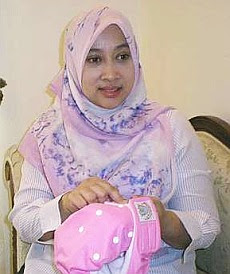
A legal eagle couldn’t bear the thought of her baby’s diapers polluting the environment. So she made her own.
DID you know that before a child is potty trained, he or she would have used up to 7,000 disposable diapers?
For 34-year-old lawyer, Azrina Azmi, the thought that her precious angel, Ayra, was polluting the environment the minute she was welcomed into the world was just too much to stomach.
“I tried the traditional diaper but it’s not very convenient for working mothers or babysitters.
Enterprising spirit: Azrina Azmi established Fresh Bots with the aim of making attractive and affordable modern cloth diapers.
“Then, I started buying modern cloth diapers from overseas but the shipping costs made them very expensive,” Azrina explains. “That’s when I decided to make my own.
“I only had basic sewing skills with my daughter as model and tester. I used up bales of cloth before I found the right fit and, more importantly, a cloth diaper that works just as well as a disposable!”
After establishing Fresh Bots (derived from the words “fresh bottom”) in 2003, this legal eagle experimented with various designs and materials before coming out with a prototype.
Holding up a gorgeous Raspberry coloured diaper, Azrina explains that modern cloth diapers are as convenient as disposables but, unlike the latter, can be washed and used again and again.
The use of snap buttons or Velcro straps replace the need for safety pins.
“New mothers don’t need to learn how to fold or pin diapers! More importantly, parents save a lot in the long run when they switch to cloth diapers,” she said.
“Disposable diapers cost an average of RM0.60 a diaper, so you’d spend around RM4,200 for one child.
“Compare that with RM1,530 for a set of cloth diapers (around 27 pieces) and you’ve saved RM2,670.
“If you have a second child, you can save RM5,000, since the same set of diapers can be used.” Azrina agrees that cleaning cloth diapers is a common concern for parents, but says, “mothers who are put off by washing solids on their baby’s diapers can use a liner, which is thrown away.”
She says they can also soak the diapers for 15-30 minutes to expel urine.
Azrina says that only a third of the normal amount of detergent is needed to wash the diapers and that no bleach or softener is needed.
“Our hot Malaysian sun acts as a natural bleach and mothers can opt for an extra rinse to remove any residue.”
Parents keen to try modern cloth diapers will be pleased to know that cloth diapering is a healthier option for their children.
For good hygiene, paediatricians recommend that newborns be changed about 10 times a day while older babies should be changed about six times.
Regular changes allow the baby’s skin to breathe, thus preventing nappy rash.
Also, cloth-diapered children potty train earlier as they learn to recognise the feeling of dampness, which is usually absent when wearing disposables.
Hearing this confident lawyer passionately sharing her experiences may lead one to think she breezed her way into this new world.
Azrina shakes her head: “It wasn’t a bed of roses. My family’s support was the key to my success and continues to be.
“My mother helps out with childcare as I’m still a full time lawyer.
“I had to source for the right materials to make the cloth diapers. Eventually, I found suitable materials from the United States.
“Another major challenge is convincing customers that Malaysian-made products are just as good as imported ones”.
Fresh Bots’ range of cloth diapers include the EASI All-In-One (100% cotton), EASI Pocket Onesize (polyester and suede with adjustable sizing and soaking ability) and EASI Pocket Original (polyester and suede in S, M, L and XL sizes).
Currently sold at baby boutiques and selected online retailers, Fresh Bot merchandise are also exported to Singapore, New Zealand and Britain.
Colourful creations: Fresh Bots’ made-in-Malaysia cloth diapers.
“Committed to quality and continuous improvement, we regularly seek feedback from our customers,” says the soft-spoken entrepreneur.
“When I started out, I wanted to make affordable cloth diapers to give mothers the choice of dressing their babies in natural, breathable fabrics.
“As we moved along, I also offered washable nursing pads, waterproof bed pads, towels and soft sole leather shoes to complement the diapers.”
When asked about future plans, Azrina shares that two new Fresh Bot diapers will be introduced in July, along with the opening of a showroom-cum-retail store in Ampang in October.
If this determined lady’s innovative and enterprising spirit hasn’t knocked your socks off, then you may be touched by her caring spirit as she also tries to help single mothers by employing them as seamstresses.
“I was raised by a single mother – I just want to help them as much as I can,” is Azrina’s simple reply.
To other entrepreneurs about to strike out on their own, she advises: “Believe in yourself and never doubt your own capability. Do not let others tell you that you cannot do it because if you don’t do it, you will never know if your business will succeed or not.
“To fail is better than not doing anything at all.”
She can be contacted at 6012-304 0811. Fresh Bots’ website is www.freshbots.com.
Tuesday, June 17, 2008
Monday, June 16, 2008
Removing urine smell
This will help restore the pH of the cloth diapers. Otherwise your baby may end up with diaper rash. Baking soda works with liquid detergents to whiten and brighten laundry. It does not boost powder detergents.
Caring the Wool
Take special care when washing and drying your wool products or they will dry out and become stiff. You may be discouraged from purchasing wool because of the extra care required but do not let that stop you from trying this wonderful fabric). It is worth the work to keep only fabrics close to your child's skin.
Steps when caring for your wool products:
1. once a week or when your wool covers become soiled, hand wash using 1 tablespoon of Eucalan Woolwash and warm water. Do not rinse. Eucalan® contains Eucalyptus which is a natural moth inhibitor and Lanolin which is a natural conditioner found in wool (Lanonlin is also known as wool fat).
2. once a month treat your wool diaper covers with Lanolin. Dissolve 1 teaspoon of lanolin in one cup of hot water. Add warm water to cool. Let your cover soak in this solution for 15 minutes. This treatment restores the water repelling properties to your cover
3. dry your wool covers by rolling it in a towel. Another option is to spin dry your wool product in the washing machine. Afterwards, hang your wool cover to dry completely. Avoid sun exposure since this may discolor your cover
Tips that need to considered to choose the right laundry detergent for cloth diaper.
1. Stick with fragrance free detergents
2. Be sure to avoid detergents with whitening enzymes.
3. Do not use bleach. Both of these products are harsh on cloth diapers. They will break down their fibers and reduce their life. Also, they are rough against your baby's skin.
4. Avoid washing cloth diapers with soap products since repeated washing with soap creates a waxy build-up that reduces the aborbancy of cloth diapers. Choose product that not fall to soap category.
Wash cloth diapers 2
To extend the life of our cloth diapers and covers, we hang them dry. It is especially important to do this with AIO's and diaper covers to preserve their waterproofing ability.
The washing instructions are for a full load of cloth diapers. You may include nylon and polyester diapers covers in this load. Handwash all wool covers.
Overnight Soak Method
Pre-Wash. (This step can be skipped if you use the wet pail method.) Place all cloth diapers in the washer, and run a prewash in cold water. This will remove most of the loose particles from the cloth diapers.
Overnight Soak. Refill the washer with cold water and 1/2 cup of baking soda. Let it agitate for a minute or two, then turn off the machine and let the cloth diapers soak several hours or overnight. Drain the water (I run a pre-wash to do this.) Baking soda is a base and neutralizes the urine in the cloth diapers. This is very effective in whitening and removing the smell from the cloth diapers.
Hot Wash. Empty the bin and run the wash with hot water, detergent and 1/2 cup Arm and Hammer Washing Soda. Since my baby has sensitive skin, I use All HypoAllergen detergent.
Double Rinse. Add about 1/2 cup of vinegar during the first rinse. If you have a washer with a fabric softener compartment pour the vinegar there when starting the hot wash. Otherwise you can throw in a Downy ball filled with vinegar.
No Soak Method
If you prefer not to soak your diapers or if you only have access to a coin operated machine follow this method:
Cold Wash. Place all your soiled cloth diapers in the machine with baking soda for a cold water wash.
Hot Wash. Add your wet cloth diapers to load, add detergent and baking soda and wash in hot water.
Rinse. Rinse cloth diapers with cold water and vinegar.
2nd Rinse. Rinse cloth diapers with cold water.
Wash Cloth Diapers 1
1. Shake "poop" into toilet. Rinse "poopy" diapers in toilet bowl. You can use a Diaper Duck or rubber gloves will help keep your hands clean.
2. Collect soiled or wet diapers in a plastic pail with no liquid added, or (only if you prefer) in a solution of water mixed with 1/4 cup of vinegar, Borateem®, Borax or Ivory Snow® Liquid.
This can help control odours and staining. Do not soak your diaper covers in this though, as it can ruin their waterproofness.
3. When ready to wash, if you've been soaking your diapers - drain excess solution into toilet. Use your spin cycle to drain the diapers of any remaining solution. Otherwise, or in addition, run your diapers through a cold wash /cold rinse presoak cycle - if you have this setting on your washing machine. For optimum cleanliness, wash only 24 diapers in an average load.
4. Then, use HOT wash and COLD rinse with high water level. If rashes are a problem, try a double rinse to remove detergent or soap residues. Use a mild soap or detergent with no phosphates, and a minimum of additives.
5. Dry in dryer on high heat for an average of 60 minutes to help sterilization. Drying in direct sunlight is also an excellent method, and it helps wonderfully with getting rid of stains.
6. Some parents like to add washing soda, vinegar or borax to the wash to keep diapers white, and to help sterilize them. Some parents prefer to boil diapers for 10 minutes once in a while, especially after a bout of diarrhea, or a yeast infection, to help prevent rash and provide optimum sterilization. But this is absolutely NOT necessary on a regular basis or for all babies.
Why Use Cloth Diaper?
It takes 82,000 tons of plastic and 1.3 millions tons of wood pulp (quarter of a million trees) to manufacture disposable diapers.
18 billion diapers are disposed in the landfills every year.
Viruses in feces from disposable diapers in landfills can leach out and contaminate underground water supplies. Some of these live viruses found in disposable diapers include polio and hepatitis.
Save money. You can save thousands of dollars by cloth diapering, more if you use cloth wipes and shop wisely. You never run out of diapers. Less diaper rash, baby is changed when wet.
Buying cloth supports family friendly companies and work at home moms instead of supporting Proctor & Gamble or Kimberly-Clark Cloth looks cuter Babies that wear cloth are easier to potty train because they know when they are wet.
Throw-away diapers whisk away wetness with chemicals, then sits on babies skin.
How Much Do Diapers Cost?
Cloth diapers can start at around $93 for a kit including three diaper covers and a day's supply of diapers. Washing costs might be Rm1.5 to Rm3.5 per laundry load. Total supplies might be Rm680-Rm1020 in the first year for diapers and wraps in different sizes as the child grows.
A cloth diaper service will drop off a week's worth of clean diapers at a time, and pick up old diapers. These services can run Rm153 -221 a month, generally, they end up being a little less expensive than disposable diapers.
Disposable diapers start around Rm 204-289 a month depending on how old your infant is (and how many changes a day you need). Many people go to warehouse discount stores and buy disposable diapers in bulk to get the best price per diaper.
Why Modern Cloth Diapers seem too expensive?
The newborn will need about 10-12 diaper(size s contains 84 diapers) changes per day in the first 4 weeks. So 1 month is about 4 packages or 336 diapers. Total cost is Rm131.6 per month.
For 1 to 5 months old babies usually need about 8-10 diaper(size M contains 70 diapers) changes a day.So about 3 packages for that month. If 1 package contains 70 diapers. The total of diapers 840 diapers for just 4 months. For a total cost of RM394.8 at regular price.
If you are lucky, your baby will still fit into diaper size M (70 diapers) for another few months. But your baby will still need about 8 changes a day from 5 to 9 months. That's another 840 diapers for the next 4 months or so. For a total cost of RM394.8 at regular price.
For baby 9-12(size L contains 60diapers) month baby still needs about 8 changes a day. So add on 13 more packages for that 3 months or 754 diapers.This really adding up ..isn't it?
So in just you baby's first year alone, you will have lugged home about 31 Jumbo-sized packages or 2796 diapers. For total outlay from your pocket of RM1348.9 at regular price.
Of course, it does get better once your baby is over a year old. For this age, the packages only contains 50 diapers,but for 12-18 months baby will need just 6 diapers changes a day, this about 22 packages or 1296 diapers for 6 months,then the total cost of RM723.8 at regular price.
For 1 year, you'll spend over RM2xxx for disposable diapers. Still, aren't all these new cloth diapers awfully expensive?
Now, how much do you plan to spend on your baby's stroller? A good-quality stroller averages around RM600.00, and your baby will use it two to six times a week, up to two hours at a time . . . for about two years.Wouldn't your back and arms agree it's worth the money?
Most parents-to-be consider the crib to be the first, and most important, purchase. An economical crib and mattress will cost you at least RM600.00, and your baby will use it from zero to eighteen hours per day.Except for those babies that prefer to sleep with Mom.That's seven days a week, for two to three years.
What value will you put on an item your baby will use 24 HOURS per day . . . SEVEN DAYS per week . . . for at least 18 MONTHS TO 3 YEARS? An item worn against the most sensitive, vulnerable and precious part of your baby's body? An item which must not only offer a comfortable, snug fit . . . but must be durable enough to last through 200 wetting, pooping, rinsing, washing and drying cycles.
Compare the value of a high-quality, convenient-to-use, long-lasting cloth diaper, averaging around RM30 each . . . your baby may not wear more than once!
Comparing this to the costs of "disposables", you would be able to recoup your initial outlay within your baby's first year.
Which means the second and third year of diapering are FREE!!!
Related Items
1. Do it yourself
Sunday, June 15, 2008
What the impact to ecological?

Since disposable diapers are discarded after a single use, usage of disposable diapers increased the burden on landfill sites, and increased environmental awareness has led to a growth in campaigns for parents to use reusable alternatives such as cloth or hybrid diapers. An estimated 27.4 billion disposable diapers are used each year in the US, resulting in a possible 3.4 million tons of used diapers adding to landfills each year. [16]
The environmental impact of cloth as compared to disposable diapers has been studied several times. In one cradle-to-grave study[17], results found that disposable diapers produce seven times more solid waste when discarded and three times more waste in the manufacturing process. In addition, effluents from the plastic, pulp, and paper industries are far more hazardous than those from the cotton-growing and -manufacturing processes. Single-use diapers consume less water than reusables laundered at home, but more than those sent to a commercial diaper service. According to industry data[18], 3.5 billion gallons of oil are used to produce the 18 million throwaway diapers that end up in landfills each year. Washing cloth diapers at home uses 50 to 70 gallons of water every three days, which is roughly equivalent to flushing the toilet five times a day, unless the user has a high-efficiancy washing machine. An average diaper service puts its diapers through an average of 13 water changes, but uses less water and energy per diaper than one laundry load at home.[19]
Care of cloth diapers
Care of disposable diapers.
Types of Diapers - Hybrid
Types of Diapers - Cloth Diapers
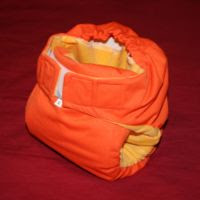
Cloth
Cloth diapers are reusable and can be made from natural fibers, manmade materials, or a combination of both. They are often made from industrial cotton which may be bleached white or left the fiber’s natural color. Other natural fiber cloth materials include wool, bamboo, and unbleached hemp. Manmade materials such as an internal absorbent layer of microfiber toweling or an external waterproof layer of polyurethane laminate (PUL) may be used. Polyester fleece and faux suedecloth are often used inside cloth diapers as a "stay-dry" wicking liner because of the non-absorbent properties of synthetic fibers.
Traditionally, cloth diapers consisted of a folded square or rectangle of cloth, fastened with safety pins.
Modern cloth diapers come in a host of shapes, including preformed cloth diapers, all-in-one diapers with waterproof exteriors, and pocket or "stuffable" diapers, which consist of a water-resistant outer shell sewn with an opening for insertion of absorbent material inserts. Closure methods include snap closures, hook and loop fasteners (such as Velcro), and other new closure methods such as the Snappi., a three-point, pin-free closure device
Types of Diapers - Disposable diapers

Disposable
Modern disposable baby diapers and incontinence products have a layered construction, which allows the transfer and distribution of urine to an absorbent core structure where it is locked in.
A disposable diaper may also include an inner fabric designed to hold moisture against the skin for a brief period before absorption to alert a toilet training or bedwetting user that they have urinated. Some disposable diapers include fragrances, lotions or essential oils in order to help mask the scent of a soiled diaper or to protect the skin.
Who is worn diapers? Astronaut worn diapers?
These can include the elderly, those with a physical or mental disability, and people working in extreme conditions such as astronauts.
Diapers are usually worn out of necessity rather than choice, although there are exceptions; people such as infantilists and diaper fetishists wear diapers recreationally for comfort, emotional fulfillment, or sexual gratification.
What cloth diapers and disposable diapers made from?
Disposable diapers contain absorbent chemicals and are thrown away after use.
What is Diaper ?
Nappy or diaper, a garment for incontinent infants amongst others .
A diaper (in North America) or nappy (in the United Kingdom, many Commonwealth countries and Ireland) is an absorbent garment worn by individuals who are incapable of controlling their bladder or bowel movements, or are unable or unwilling to use a toilet. The purpose of a diaper is to absorb moisture and contain mess so that the wearer can remain dry and comfortable after wetting or soiling themselves. When diapers become full and can no longer hold any more waste, they require changing; this process is often performed by a secondary person such as a parent or caregiver.
Failure to change a diaper on a regular enough basis can result in diaper rash.
Blog Archive
-
▼
2008
(43)
-
►
06/15 - 06/22
(24)
- What is Diaper ?
- What cloth diapers and disposable diapers made from?
- Who is worn diapers? Astronaut worn diapers?
- Types of Diapers - Disposable diapers
- Types of Diapers - Cloth Diapers
- Types of Diapers - Hybrid
- Care of disposable diapers.
- Care of cloth diapers
- What the impact to ecological?
- Why Modern Cloth Diapers seem too expensive?
- How Much Do Diapers Cost?
- Why Use Cloth Diaper?
- Wash Cloth Diapers 1
- Wash cloth diapers 2
- Tips that need to considered to choose the right ...
- Caring the Wool
- Removing urine smell
- How to Use Snappi Fasterner
- Reference
- Green Diaper
- Regular Care of Cloth Diaper
- Environment Laundry Detergent for cloth diaper
- Do it Yourself Cloth Diaper
- What you need to know before buy the cloth diaper
-
►
06/22 - 06/29
(14)
- 10 Interesting Tips of money saving from Fuzz Bunz
- Autumn Beck said, "Don't be afraid to use bleach"
- Are cloth or disposable diapers best during travel?
- Diaper cover
- Pocket Diaper
- How to change a cloth diaper (YouTube)
- Intro to Cloth Diapering (YouTube )
- How to put on a prefold diaper(YouTube)
- All-In-One (AIO) Diaper(YouTube)
- How to sew a cloth diaper (YouTube)
- Cleaning Cloth Diaper (YouTube)
- All in One cloth diaper (see on the baby)
- What is All in One cloth diaper? (for working moth...
- How to wear prefold diaper (YouTube)
-
►
06/15 - 06/22
(24)

